- Home
- Executive summary
- Territories
- Kisimbosa – DR Congo
- Yogbouo – Guinea
- Fokonolona of Tsiafajavona – Madagascar
- Kawawana – Senegal
- Lake Natron – Tanzania
- Qikiqtaaluk – Canada
- Sarayaku – Ecuador
- Komon Juyub – Guatemala
- Iña Wampisti Nunke – Peru
- Hkolo Tamutaku K’rer – Burma/Myanmar
- Fengshui forests of Qunan – China
- Adawal ki Devbani – India
- Tana’ ulen – Indonesia
- Chahdegal – Iran
- Tsum Valley – Nepal
- Pangasananan – Philippines
- Homórdkarácsonyfalva Közbirtokosság – Romania
- National and regional analyses
- Global analysis
The Zhuang Indigenous community of Qunan revitalised the governance of its territory of life by establishing an environmental education base. Focusing on the value of its biocultural diversity and the active conservation of the critically endangered white-headed langur, the Qunan community obtained governmental recognition and appreciation from the national public as a community conserved area. With custodianship over the territory, Qunan also gained an increased sense of pride in their cultural heritage as a value to be passed on to future generations.
Located in the Guangxi Zhuang Autonomous Region in southern China, the community of Qunan is comprised of 450 individuals (110 households), who belong to the Zhuang Indigenous people.[1] The Qunan territory of life dates back at least 300 years. Today, the community holds the collective rights over about 1,010 hectares in total, including Fengshui forests, other forests, agricultural areas, and water bodies.
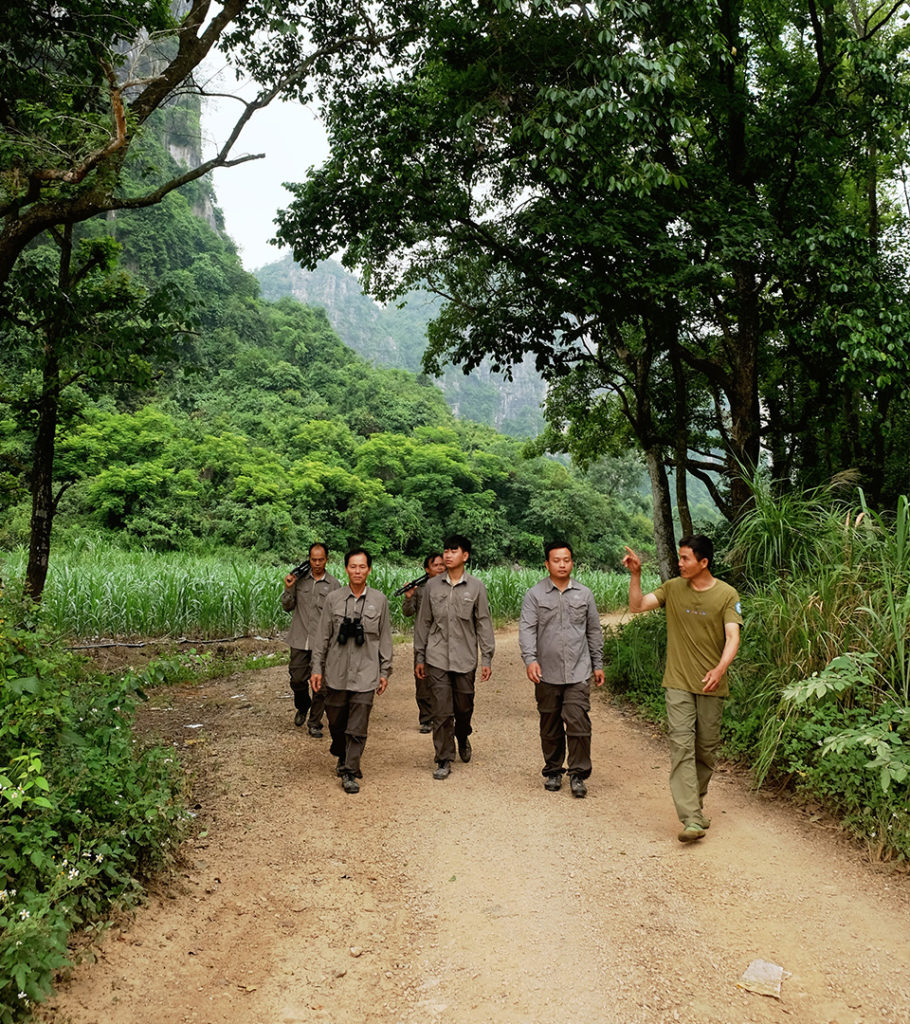
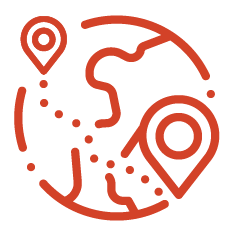
The Qunan territory of life dates back at least 300 years
1,010 hectares

Custodians: Community of Qunan, 450 residents
The Zhuang people have been known for safeguarding the Fengshui forests surrounding their villages.[2] The vitality of these forests is believed to indicate the health, fortune, and well-being of their custodians. Fengshui forests are places of worship; some old trees in the village are also held sacred, and each hill within the territory has its own guardian spirit. Fengshui forests play important roles in preserving water resources, preventing natural disasters such as rockfall, and contributing to local peoples’ livelihoods.
The Qunan territory is rich in endemic biodiversity, falling into the Sino-Vietnam Biodiversity Corridor of the Indo-Burma hotspot (one of 36 global biodiversity hotspots).[3] The biodiversity baseline surveys conducted by the Guangxi Biodiversity Research and Conservation Association (BRC) showed that the limestone seasonal rainforest of Qunan provides refuge for white-headed langur, rhesus macaque, wild boar, musk deer, python, gecko, and other wildlife. The most significant of these species is the white-headed langur (Trachypithecus poliocephalus). Endemic to a small area of about 200 km2 between the Ming and Zuo rivers in Guangxi, the white-headed langur was once listed as one of the 25 most endangered species in the world, with a global population of just about 1,200 in 2017.[4] Today, it is still listed as critically endangered by the International Union for Conservation of Nature,[5] although the numbers have recovered, thanks in part to the conservation efforts of the Qunan community: in November 2019, a survey in Qunan territory counted 249 individuals in 31 groups.[6] This result is in line with the villagers’ observation that both forests and langurs have been recovering steadily over the past 20 years.
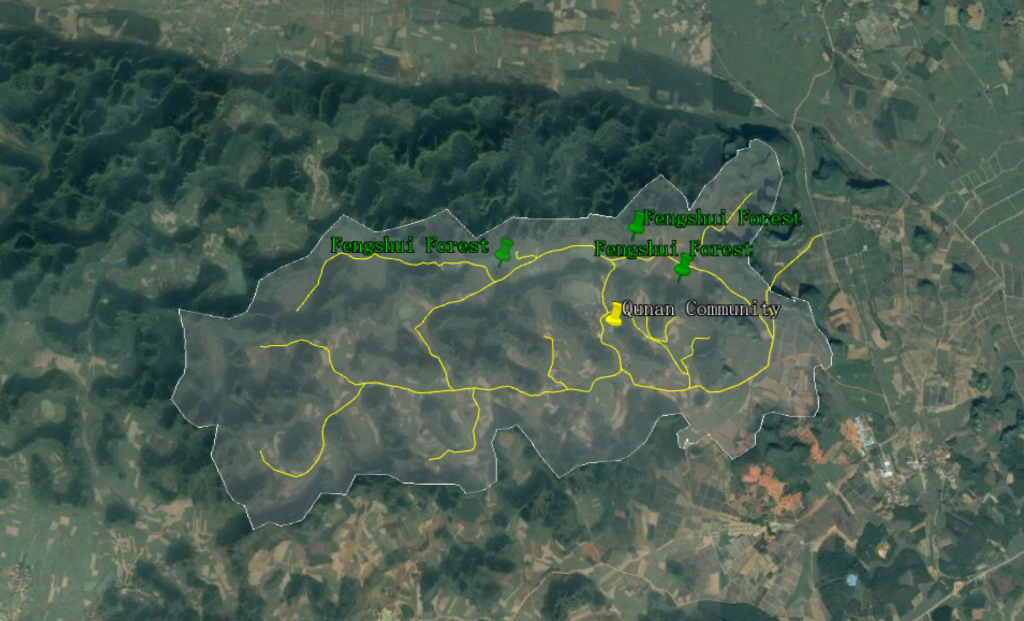
Collective governance and management as the key to successful conservation
Fengshui forests are essential to the daily life of people in Qunan for their ecological, cultural and spiritual values. Within the Qunan territory of life there are three patches of Fengshui forests: one is primary, one restored, and the third was planted over 70 years ago. All of them are well protected and well respected as the residences of the guardian spirits of the Qunan community. For instance, if people eat in their territories, they should share food with the spirits or else the spirits will be offended. Transmitted from generation to generation through legends, stories, and traditional practices, such traditions remain important today, although there have been notable changes as well. Traditionally, all families of Qunan used to assemble every year on the Lunar date of 4 May at the front of the Sacred Dragon Temple in one of the Fengshui forests. Not just a religious gathering, this was an important occasion for conflict resolution and collective discussion of public affairs. However, since the 1980s, this institution has gradually weakened as the officially elected and government-supported Qunan Management Committee became more politically powerful. Now, it mainly serves as a religious festival to enhance communal solidarity.
In the 1980s, when communal farmland was allocated to each household under a new government policy, some forests at the foot of the characteristic limestone hills were seriously encroached by agriculture and animal husbandry. Across the country, this policy resulted in large-scale deforestation for the opening of more farmland. Deforestation was banned at the beginning of the 1990s; today, commercial logging is prohibited and the natural forest in Qunan is under the protection of a national payment for ecological services programme, with direct payments to each household.
In recent years, many farmers switched their cash crops from sugarcane to oranges. The orange orchards not only require more financial and labour investment, but also cause serious air and soil pollution due to the use of pesticides. The market price of oranges has fluctuated greatly, and some families have taken loans they have to pay back. In contrast, the revenue from sugarcane is low but stable, as the market is controlled by the government as a poverty alleviation measure.
Despite the fact that these cash crops are the main livelihood source today, the Qunan community still conserves traditional seed varieties (e.g., peanuts and soybeans, which form part of the traditional food). They also use a variety of wild plants for food, medicine, dyeing, and building materials. However, the youth are losing this traditional knowledge as they attend schools away from the community and only go back home on weekends or holidays.
An important change came in 2012 when the state designated the Chongzuo White-headed Langur National Nature Reserve in the direct vicinity of Qunan. Since the forests of Qunan territory are part of the habitat of the critically endangered white-headed langurs, the Reserve and local forestry bureau were very interested in obtaining support from the Qunan community for their protection. A new provincial policy was issued in 2014, encouraging local communities to register and manage their conserved area on their own collective land. Recognising that the Qunan community valued and conserved their territory well, the local NGO BRC reached an agreement with the Reserve to jointly facilitate Qunan to get official recognition and enhance its self-governance and management of the territory.

In addition, BRC proposed to establish an environmental education base in Qunan. Realising that a prosperous market for environmental education activities was emerging, Qunan seemed an ideal destination for the educational camps focusing on langur and limestone ecosystem conservation. These ideas were welcomed and approved by all households of Qunan during a general assembly in late 2014, where they also agreed to seek governmental recognition and to register in the global ICCA Registry hosted by the UN Environment Programme World Conservation Monitoring Centre.
Although only part of the langur habitat in Qunan was formally recognised as a Community Conserved Area by the county forestry bureau in December 2014, Qunan still regards and manages the entire territory as an integrated whole, as they did before. The governmental recognition protects the territory from industrial projects like limestone and bauxite mining, which are causing problems in some other communities in the region.
During the 2014 assembly, the community agreed on four principles for enhancing their management of the territory: 1) outsiders are not allowed to enter their territory without permission; 2) poaching of wildlife, bird catching, illegal logging for expansion of agricultural farmland, and collecting natural resources by outsiders are prohibited; 3) fire at the foothills is not allowed; and 4) any violation witnessed should be reported.
The rules were accepted and implemented by all members. Since the main threats are from outsiders, a voluntarily patrolling group was created in early 2015, consisting of 17 young rangers. All community members participate in the surveillance and report to the rangers any violation they observe when working in the fields. If needed, the community rangers will then ask for help from the Nature Reserve to enforce the law. In the past five years, only 29 cases of illegal activities were reported; the last two were in 2018.
Since the initiation of the environmental education base, a new consultative mechanism (the “co-management committee”) was developed for both internal and external cooperation in 2015. It includes the representatives of the reserve, BRC, Qunan Management Committee, the patrolling group, the dancing group, the Homestay Association, and the Green Grass children’s group. The co-management committee holds meetings every quarter and consults on all important issues regarding environmental education and conservation of the territory. The purpose of this mechanism is to ensure the equal participation of each group in the governance and management of the ICCA as well as good cooperation with external stakeholders, such as the Nature Reserve, the forestry bureau, and NGOs. The creation of the committee was proposed initially by BRC and has generally been well accepted. However, the mechanism is facing challenges when the political power of internal and external stakeholders is unbalanced, and there is still a need to strengthen the awareness and capacity of different interest groups to address this problem.
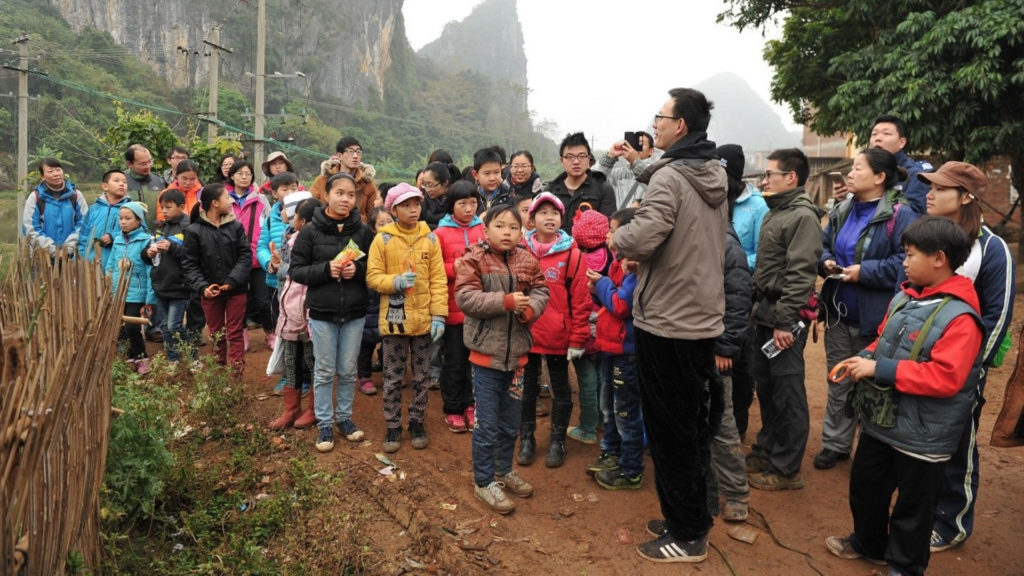
Environmental education as a driver for the revitalisation of traditions
In January 2015, Qunan successfully hosted the first winter camp together with BRC. Unlike mass tourism, the environmental education camps are open only to students whose courses are organised by reliable NGOs, and are only being held during weekends and holidays. Any camp needs permission from the Qunan community beforehand, and the students have to follow the “No-Harm-to-Environment-and-Culture Principles” established by BRC and Qunan.
The environmental education activities were welcomed by all community members. They also promoted the formation of many different groups in Qunan and their active participation in the governance and management of the territory: the Homestay Association, the Green Grass children’s group, and the Kapok women’s nature guide group.
The first group established was the Homestay Association comprised of 15 families who mainly provide meals and lodgings (68 beds) for environmental education camps. The Association has the right to decide whether and how to host the students to avoid any negative impacts to their traditional culture and make sure the income is equally distributed among all members. About 11 per cent of the income goes into the collective community fund, in addition to the rent of rooms and equipment.
Qunan used to be a marginalised community, remote from urban centres and with very limited public services and infrastructure. The environmental education camps not only attract students and their parents from big cities across China, but also the children from Qunan itself are free to join. Thus, due to the appreciation shown by the visitors, the children of Qunan are becoming prouder and prouder of their territory and culture. They established their own association called Green Grass, with its own rules and procedures for member recruitment and elections. They organise to clean up garbage in the community, manage their small library donated by visitors, and also actively participate in each camp.
Another initiative emerged from a group of women who used to dance together in their spare time. Since becoming involved in designing and delivering courses about the Indigenous biological and cultural values of the territory, the group also started to perform traditional Zhuang songs and dances (with some men also joining). In 2018, some women from this group learned how to be nature guides and formed another team, named Kapok, which offers night observation courses of wildlife.
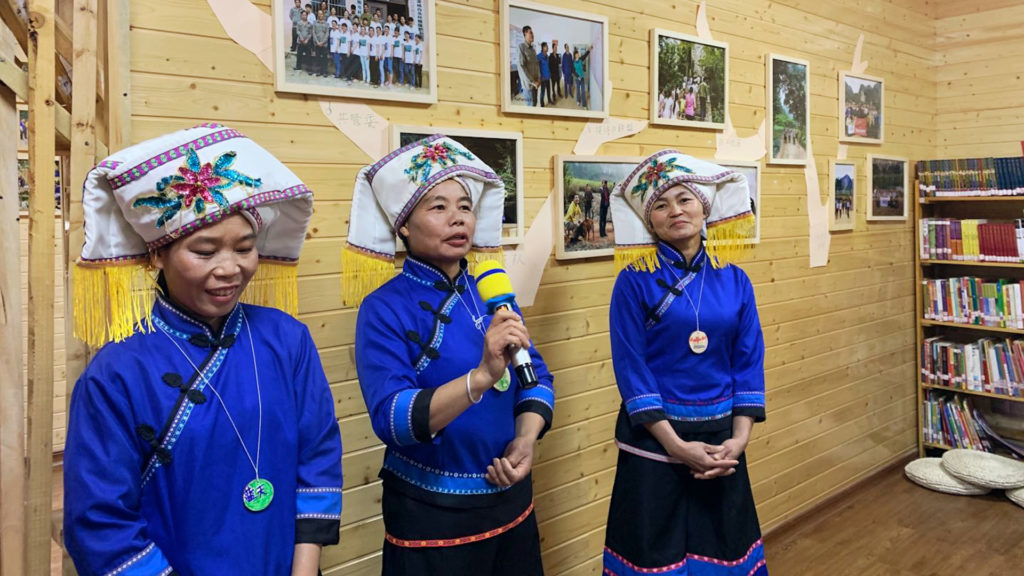
The volunteer patrolling group also plays an important role in the environmental education activities. Being trained to do field surveys and monitor wildlife, they are usually responsible for finding the langurs, teaching students how to observe their behaviour, and telling stories about them.
In the beginning, the courses offered in the environmental education camps were mainly designed and delivered by BRC with the active participation of all these groups. However, over time the community groups were able to design and provide courses on their own. In addition, the courses have extended from teaching about the langurs and limestone ecosystems to teaching about birds, butterflies, reptiles, Zhuang traditional knowledge, culture, and the history of the Qunan territory.
Challenges and new opportunities for a more sustainable future
Before any official recognition and NGO support, the Qunan people valued their territory as their homeland and source of dignity and identity. Then, the langur were categorised as critically endangered and came under special legal protection. As a result, the commitment of the Qunan community to the conservation of the langur and their habitat earned great recognition and appreciation from government and the public, which in turn enhanced the awareness and pride of Qunan about their custodianship over the territory.
Although the langur and its habitat have been well conserved up to now, the current livelihoods of Qunan are not sustainable in the long-term. Community members are very anxious about the market price of their harvest, especially when more and more families replace sugarcane with oranges, with serious environmental impacts. Since the Qunan people now need cash for education, medical and other expenses, it is not easy for them to change their livelihoods toward a more sustainable and self-reliant way.
Realising the pollution and the harm to their health caused by pesticides and fertilisers, the Kapok women’s group has started exploring permaculture agriculture on a small barren island in the village pond, changing it into an organic vegetable garden. This action, which received support from other groups, may be used for designing environmental education courses on sustainable gardening in the future.
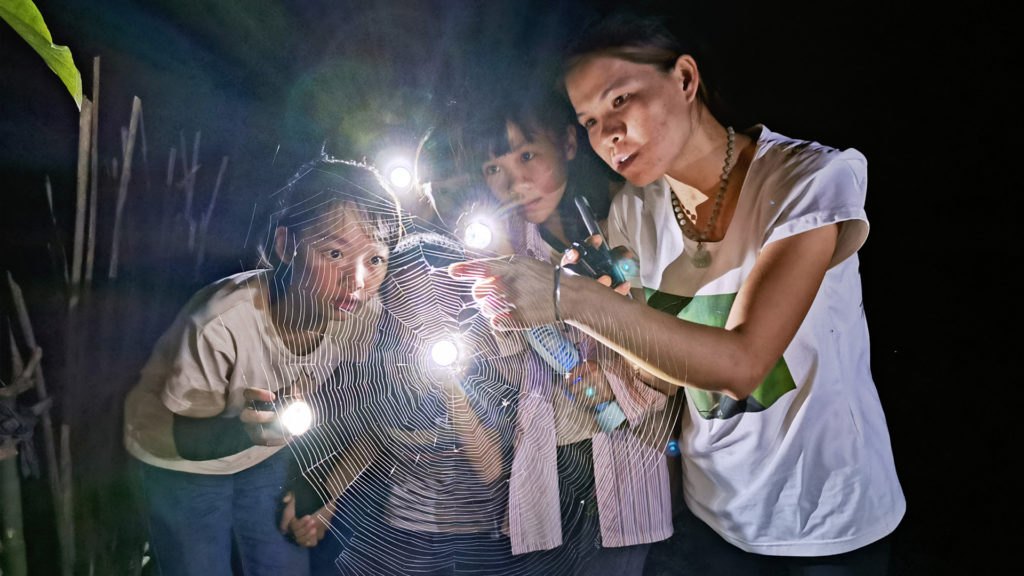
The community members hope that the environment education base could generate more income and play a more important role in their livelihoods in the future. Being more confident in their management capacities, they expect that more visitors could come to Qunan without negatively impacting their nature and culture. However, they also realise that they still rely heavily on external partners to organize camps and design courses. If the community opens the door to tourists, it may require more infrastructure development that the community may not be able to afford both financially and environmentally. External investments might create power imbalances among the different groups within the community, undermining their self-governance.
Taking such questions into consideration, the overall experience has so far been positive, and the emergence of different groups within the community has led to an increase in participation and equity among its members. Today, the environmental education courses show the rich biodiversity and inherent cultural and spiritual values of this territory. The external appreciation makes the Qunan people more aware and proud of their traditional culture and knowledge. Being confident about its values to the region and the world, they reflect on their relationship with nature, identify challenges and improve their own management and governance.
[1] The Tai-speaking Zhuang people are among the largest and best-known of the 56 “ethnic minority groups” officially recognised by the People’s Republic of China, with an estimated 18 million members, and over 2000 years of historical records.
[2] In China, fengshui forests are an ancient cultural-religious phenomenon with many different manifestations. See, e.g., Bixia Chena, Chris Cogginsb, Jesse Minorc, Yaoqi Zhang. 2018. ‘Fengshui forests and village landscapes in China: Geographic extent, socioecological significance, and conservation prospects’, Urban Forestry & Urban Greening 31: 79-92.
[3] Ecosystem Profile, Indo-Burma Biodiversity Hotspot 2011 Update, Critical Ecosystem Partnership Fund, October 2012. (https://www.cepf.net/our-work/biodiversity-hotspots/indo-burma)
[4] The latest survey conducted by the Chongzuo Municipal Forestry Bureau in 2017 counted about 1,000 individuals (http://www.czbtyh.cn/bhqgk/423822.shtml); according to personal communication with staff, there are about 200 more in the Nonggang National Nature Reserve.
[5] Bleisch, B., Xuan Canh, L., Covert, B. & Yongcheng, L. 2008. Trachypithecus poliocephalus. The IUCN Red List of Threatened Species 2008: e.T22045A9351127.
[6] Unpublished data from BRC who organized and carried out the survey together with Qunan community members.
